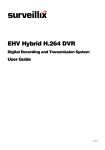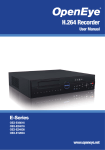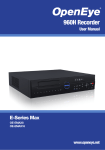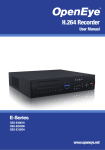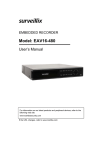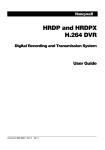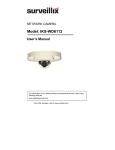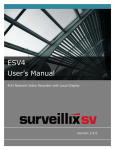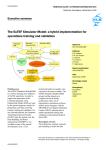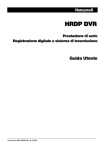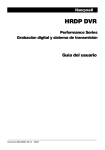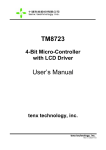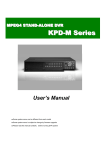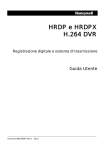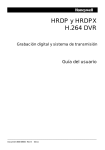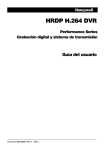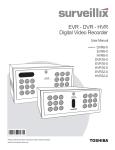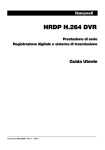Download EHV Hybrid H.264 DVR Operation Manual
Transcript
EHV Hybrid H.264 DVR Digital Recording and Transmission System User Guide 31041AC Surveillix™ EHV User Manual Manual Edition 31041AC – JULY 2012 Printed in USA No part of this documentation may be reproduced in any means, electronic or mechanical, for any purpose, except as expressed in the Software License Agreement. Toshiba America Information Systems (TAIS) shall not be liable for technical or editorial errors or omissions contained herein. The information in this document is subject to change without notice. The information in this publication is provided “as is” without warranty of any kind. The entire risk arising out of the use of this information remains with recipient. In no event shall TAIS be liable for any direct, consequential, incidental, special, punitive, or other damages whatsoever (including without limitation, damages for loss of business profits, business interruption or loss of business information), even if TAIS has been advised of the possibility of such damages and whether in an action or contract or tort, including negligence. This software and documentation are copyrighted. All other rights, including ownership of the software, are reserved to DVR Support Center. TAIS, and Surveillix are registered trademarks of TAIS in the United States and elsewhere; Windows, and Windows 7are registered trademarks of Microsoft Corporation. All other brand and product names are trademarks or registered trademarks of the respective owners. The following words and symbols mark special messages throughout this guide: WARNING: Text set off in this manner indicates that failure to follow directions could result in bodily harm or loss of life. CAUTION: Text set off in this manner indicates that failure to follow directions could result in damage to equipment or loss of information. ________________________________________________________________________________________________________ 2 LIMITED WARRANTY DIGITAL VIDEO RECORDER The Imaging Systems Division of Toshiba America Information Systems, Inc. (“ISD”) makes the following limited warranties. These limited warranties extend to the Original End-User (“You[r]”). Limited Three (3) Year Warranty of Labor and Parts The Imaging Systems Division of Toshiba America Information Systems warrants this product and parts against defects in material or workmanship for a period of three (3) years from the date of original retail purchase by the end-user. The first year of the three year warranty period will cover advance replacement of a defective unit and the remaining two years will be repaired by the Surveillix DVR Support Center factory. During this period, ISD will repair or replace a defective product or part with a new or refurbished item. The user must deliver the entire product to the Surveillix DVR Repair Facility. The user is responsible for all transportation and insurance charges for the product to the DVR Repair Facility. ISD reserves the right to substitute Factory Refurbished Parts and / or Factory Refurbished Product in place of those in need of repair. Step-by-step Procedures – How to Obtain Warranty Service [1] Verify operation of the unit by checking the instruction manual and web site for the latest updates at www.toshibasecurity.com [2] If there is a defect in material or workmanship, contact the Surveillix DVR Support Center at (877) 855-1349 [877-855-1-FIX] to speak to a technical support representative and schedule service. [3] Arrange for delivery of the product to the Surveillix DVR Repair Facility. Products must be insured and securely packed, preferably in the original shipping carton. A letter explaining the defect and a copy of the bill of sale or other proof of purchase must be enclosed with a complete return street address and daytime telephone number. The Tracking Number should also be indicated on your documents. Charges for transportation and insurance must be prepaid by the end-user. Critical Use Disclaimer The product is not designed for any “critical applications.” “Critical applications” means life support systems, exhaust or smoke extraction applications, medical applications, commercial aviation, mass transit applications, military applications, homeland security applications, nuclear facilities or systems or any other applications where product failure could lead to injury to persons or loss of life or catastrophic property damage. Accordingly, TAIS disclaims any and all liability arising out of the use of the product in any critical applications. Your Responsibilities The above warranty is subject to the following conditions: [1] You must retain the bill of sale or provide other proof of purchase. [2] You must schedule service within thirty days after you discover a defective product or part. [3] All warranty servicing of this product must be made by the Surveillix DVR Repair Facility. [4] The warranty extends to defects in material or workmanship as limited above, and not to any products or parts that have been lost or discarded by user. The warranty does not cover damage caused by misuse, accident, improper installation, improper maintenance, or use in violation of instructions furnished by ISD. The warranty does not extend to units which have been altered or modified without authorization of ISD, or to damage to products or parts thereof which have had the serial number removed, altered defaced or rendered illegible. ALL WARRANTIES IMPLIED BY STATE LAW, INCLUDING THE IMPLIED WARRANTIES OF MERCHANTABILITY AND FITNESS FOR A PARTICULAR PURPOSE, ARE EXPRESSLY LIMITED TO THE DURATION OF THE LIMITED WARRANTIES SET FORTH ABOVE. Some states do not allow limitations on how long an implied warranty lasts, so the above limitation may not apply. WITH THE EXCEPTION OF ANY WARRANTIES IMPLIED BY STATE LAW AS HEREBY LIMITED, THE FOREGOING EXPRESS WARRANTY IS EXCLUSIVE AND IN LIEU OF ALL OTHER WITH RESPECT TO THE REPAIR OR REPLACEMENT OF ANY PRODUCTS OR PARTS. IN NO EVENT SHALL ISD BE LIABLE FOR CONSEQUENTIAL OR INCIDENTAL DAMAGES. Some states do not allow the exclusion or limitation of incidental or consequential damages so the above limitation may not apply. No person, agent, distributor, dealer, service station or company is authorized to change, modify or extend the terms of these warranties in any manner whatsoever. The time within which an action must be commenced to enforce any obligation of ISD arising under this warranty or under any statute, or law of the United States or any state thereof, is hereby limited to one year from the date you discover or should have discovered, the defect. This limitation does not apply to implied warranties arising under state law. Some states do not permit limitation of the time within which you may bring an action beyond the limits provided by state law so the above provision may not apply to user. This warranty gives the user specific legal rights, and user may also have other rights, which may vary from state to state. TOSHIBA AMERICA INFORMATION SYSTEMS, INC. Imaging Systems Division Copyright © 2012 Toshiba America Information Systems, Inc. All rights reserved. ________________________________________________________________________________________________________ 3 IMPORTANT SAFEGUARDS 1. 2. 3. 4. 5. 6. 7. 8. 9. 10. 11. 12. 13. 14. 15. 16. Read Owner’s Manual – After unpacking this product, read the owner’s manual carefully, and follow all the operating and other instruction Power Sources – This product should be operated only from the type of power source indicated on the label. If you are not sure of the type of power supply to your home or business, consult your product dealer or local power company Ventilation – Slots and openings in the cabinet are provided for ventilation and to ensure reliable operation of the product and to protect it from overheating, and these openings must not be blocked or covered. The product should not be placed in a built-in installation such as a bookcase or rack unless proper ventilation is provided or the manufacturer’s instructions have been adhered to. Heat – The product should be situated away from heat sources such as radiators, heat registers, stoves, or other products that produce heat. Water and Moisture – Do not use this product near water. Cleaning – Unplug this product from the wall outlet before cleaning. Power Cord Protection – Power-supply cords should not be routed so that they are not likely to be walked on or pinched by items placed against them, paying particular attention to cords at plugs, convenience receptacles, and the point where they exit from the product. Overloading – Do not overload wall outlets; extension cords, or integral convenience receptacles as this can result in a risk of fire or electrical shock. Lightning – For added protection for this product during storm, or when it is left unattended and unused for long periods of time, unplug it from the wall outlet. This will prevent damage to the product due to lightning and power line surges. Object and Liquid Entry Points – Never insert foreign objects into the recorder, other than the media types approved by TAIS as they may touch dangerous voltage points or short-out parts that could result in a fire or electrical shock. Never spill liquid of any kind on the product. Accessories – Do not place this product on an unstable cart, stand, tripod, bracket, or table. The product may fall, causing serious personal injury and serious damage to the product. Burden – Do not place a heavy object on or step on the product. The object may fall, causing serious personal injury and serious damage to the product. Disc – Do not use a cracked, deformed, or repaired disc. These discs are easily broken and may cause serious personal injury and product malfunction. LAN Port - This equipment is for indoor use and all the communication wirings are limited to inside of the building. Damage Requiring Service – Unplug the unit from the outlet and refer servicing to qualified service personnel under the following conditions: a) When the power-supply cord or plug is damaged. b) If liquid has been spilled, or objects have fallen into the unit. c) If the unit has been exposed to rain or water. d) If the unit does not operate normally by following the operating instructions. Adjust only those controls that are covered by the operating instructions as an improper adjustment of other controls may result in damage and will often require extensive work by a qualified technician to restore the unit to its normal operation. e) If the unit has been dropped or the enclosure has been damaged. f) When the unit exhibits a distinct change in performance - this indicates a need for service. Servicing – Do not attempt to service this product yourself as opening or removing covers may expose you to dangerous voltage or other hazards. Refer all servicing to qualified personnel. ________________________________________________________________________________________________________ 4 17. Replacement Parts – When replacement parts are required, be sure the service technician has used replacement parts specified by the manufacturer or have the same characteristics as the original part. Unauthorized substitutions may result in fire, electric shock or other hazards. 18. Safety Check – Upon completion of any service or repairs to this unit, ask the service technician to perform safety checks to determine that the unit is in proper operating condition. BATTERY EXPLOSION CAUTION STATEMENT CAUTION: Risk of Explosion if Battery is replaced by an Incorrect Type. Dispose of Used Batteries According to the Instructions. NOTES ON HANDLING Please retain the original shipping carton and/or packing materials supplied with this product. To ensure the integrity of this product when shipping or moving, repackage the unit as it was originally received from the manufacturer. Do not use volatile liquids, such as aerosol spray, near this product. Do not leave rubber or plastic objects in contact with this product for extended periods of time. Rubber or plastic objects left in contact with this product for extended periods of time will leave marks on the finish. The top and rear panels of the unit may become warm after long periods of use. This is not a malfunction. NOTES ON LOCATING Place this unit on a level surface. Do not use it on a shaky or unstable surface such as a wobbling table or inclined stand. If this unit is placed next to a TV, radio, or VCR, the playback picture may become poor and the sound may be distorted. If this happens, place the recorder away from the TV, radio, or VCR. AVOID VOLATILE LIQUID Do not use volatile liquids, such as an insect spray, near the unit. Do not leave rubber or plastic products touching the unit for a long time. They will leave marks on the finish. Do not use a chemically saturated cloth. NOTES ON MAINTENANCE To keep the recorder always operational we recommend regular inspection maintenance (cleaning parts or replacement). For details, contact the nearest dealer. ________________________________________________________________________________________________________ 5 NOTES ON MOISTURE CONDENSATION Moisture condensation damages the recorder. Read the following information carefully. Moisture condensation occurs during the following cases: • When this product is brought directly from a cool location to a warm location. • When this product is moved to a hot and humid location from a cool location. • When this product is moved to a cool and humid location from a warm location. • When this product is used in a room where the temperature fluctuates. • When this product is used near an air-conditioning unit vent • When this product is used in a humid location. Do not use the recorder when moisture condensation may occur. If the recorder is used in such a situation, it may damage discs and internal parts. Connect the power cord of the recorder to the wall outlet, turn on the recorder, and leave it for two to three hours. After two to three hours, the recorder will warm up and evaporate any moisture. Keep the recorder connected to the wall and moisture will seldom occur. CAUTION CAUTION RISK OF ELECTRIC SHOCK DO NOT OPEN CAUTION: TO REDUCE THE RISK OF ELECTRIC SHOCK, DO NOT REMOVE COVER (OR BACK). NO USER-SERVICEABLE PARTS INSIDE. REFER SERVICING TO QUALIFIED SERVICE PERSONNEL. ________________________________________________________________________________________________________ 6 RACK MOUNT INSTRUCTIONS Elevated Operating Ambient – If installed in a closed or multi-unit rack assembly, the operating ambient temperature of the rack environment may be greater than room ambient. Therefore, consideration should be given to installing the equipment in an environment compatible with the maximum ambient temperature specified by the manufacturer. Reduced Air Flow – Installation of the equipment in a rack should be such that the amount of airflow required for safe operation of the equipment is not compromised. Mechanical Loading – Mounting of the equipment in the rack should be such that a hazardous condition is not achieved due to uneven mechanical loading. Circuit Overloading – Consideration should be given to the connection of the equipment to the supply circuit and the effect that overloading of the circuits might have on over current protection and supply wiring. Appropriate consideration of equipment nameplate ratings should be used when addressing this concern. Grounding – Grounding of rack-mounted equipment should be maintained. Particular attention should be given to supply connections other than direct connections to the branch circuit (e.g. use of power strips). FCC STATEMENT INFORMATION TO THE USER: This equipment has been tested and found to comply with the limits for a Class B digital device, pursuant to Part 15 of the FCC Rules. These limits are designed to provide reasonable protection against harmful interference in a residential installation. This equipment generates, uses and can radiate radio frequency energy and, if not installed and used in accordance with the instructions, may cause harmful interference to radio communications. However, there is no guarantee that interference will not occur in a particular installation. If this equipment does cause harmful interference to radio or television reception, which can be determined by turning the equipment off and on, the user is encouraged to try to correct the interference by one or more of the following measures: • Reorient or relocate the receiving antenna. • Increase the separation between the equipment and receiver. • Connect the equipment into an outlet on a circuit different from that to which the receiver is connected. • Consult the dealer or an experienced radio/TV technician for help. USERS OF THE PRODUCT ARE RESPONSIBLE FOR CHECKING AND COMPLYING WITH ALL FEDERAL, STATE, AND LOCAL LAWS AND STATUTES CONCERNING THE MONITORING AND RECORDING OF VIDEO AND AUDIO SIGNALS. TAIS SHALL NOT BE HELD RESPONSIBLE FOR THE USE OF THIS PRODUCT IN VIOLATION OF CURRENT LAWS AND STATUTES. ________________________________________________________________________________________________________ 7 UL NOTICE Underwriters Laboratories Inc. has not tested the performance or reliability of the security or signaling aspects of this product. UL has only tested for fire, shock and casualty hazards as outlined in UL’s Standard for Safety UL 60950-1. UL Certification does not cover the performance or reliability of the security or signaling aspects if this product. UL MAKES NO REPRESENTATIONS, WARRANTIES OR CERTIFICATIONS WHATSOEVER REGARDING THE PERFORMANCE OR RELIABILITY OF ANY SECURITY OR SIGNALING RELATED FUNCTIONS OF THIS PRODUCT. Disclaimer We disclaim any responsibility and shall be held harmless for any damages or losses incurred by the user in any of the following cases: 1. Fire, earthquake or any other act of God; acts by third parties; misuse by the user, whether intentional or accidental; use under extreme operating conditions. 2. Malfunction or non-function resulting in indirect, additional or consequential damages, including but not limited to loss of expected income and suspension of business activities. 3. Incorrect use not in compliance with instructions in this user's manual. 4. Malfunctions resulting from misconnection to other equipment. 5. Repairs or modifications made by the user or caused to be made by the user and carried out by an unauthorized third party. 6. Notwithstanding the foregoing, TAIS’ liabilities shall not, in any circumstances, exceed the purchase price of the product. Usage Limitation The product is not designed for any "critical applications." "Critical applications" means life support systems, exhaust or smoke extraction applications, medical applications, commercial aviation, mass transit applications, military applications, homeland security applications, nuclear facilities or systems or any other applications where product failure could lead to injury to persons or loss of life or catastrophic property damage. Accordingly, TAIS disclaims any and all liability arising out of the use of the product in any critical applications. ________________________________________________________________________________________________________ 8 CONTENTS 1 Contents .................................................................................................................................................................................. 9 2 Introduction ........................................................................................................................................................................... 13 Product Description ......................................................................................................................................... 13 Features .......................................................................................................................................................... 13 USB Flash Drive Approved List ....................................................................................................................... 14 PTZ Compatibility List ..................................................................................................................................... 14 Quick Start Instructions ................................................................................................................................... 15 Logging In for the First Time ........................................................................................................................... 15 3 Installation ............................................................................................................................................................................. 16 Front Panel Controls ....................................................................................................................................... 16 Rear Panel Connectors ................................................................................................................................... 16 16 Channel ............................................................................................................................................. 16 8 Channel ............................................................................................................................................... 17 4 Channel ............................................................................................................................................... 17 D1 ........................................................................................................................................................... 18 Remote Control ............................................................................................................................................... 19 Connection Guide ............................................................................................................................................ 20 Connecting the Monitor .......................................................................................................................... 20 Connecting to a Network ........................................................................................................................ 20 Connecting Audio ................................................................................................................................... 20 Connecting a PTZ Camera ..................................................................................................................... 20 Connecting to a Sensor Input ................................................................................................................. 20 Connecting to a Relay Output ................................................................................................................ 21 Installing the Rackmount Kit ............................................................................................................................ 21 Turning on the REcorder ................................................................................................................................. 21 Using the Power Button .......................................................................................................................... 21 Setting the Remote Controller ID .................................................................................................................... 22 4 Setup ...................................................................................................................................................................................... 23 Setup Menus ................................................................................................................................................... 23 Quick Setup ..................................................................................................................................................... 24 System............................................................................................................................................................. 25 System Configuration ............................................................................................................................. 25 Upgrade Firmware .................................................................................................................................. 26 Disk Configuration .................................................................................................................................. 27 Format ........................................................................................................................................... 27 HDD Overwrite ............................................................................................................................... 28 Check ............................................................................................................................................. 29 SMART Check ............................................................................................................................... 30 User Configuration.................................................................................................................................. 31 Adding / Changing a User.............................................................................................................. 31 Configuration .......................................................................................................................................... 32 Shutdown ................................................................................................................................................ 32 ________________________________________________________________________________________________________ 9 Camera ............................................................................................................................................................ 33 Camera Configuration ............................................................................................................................ 33 Adding a Privacy Zone................................................................................................................... 33 Color Setup (Adjust) ...................................................................................................................... 34 PTZ Configuration .................................................................................................................................. 34 Spot / Sequence Configuration .............................................................................................................. 35 Monitor Configuration ............................................................................................................................. 36 Record ............................................................................................................................................................. 37 Recording Configuration ......................................................................................................................... 37 Frame ............................................................................................................................................ 37 IP Camera ...................................................................................................................................... 38 Schedule ........................................................................................................................................ 38 Holiday Setup ................................................................................................................................ 40 Audio .............................................................................................................................................. 41 Instant Recording........................................................................................................................... 42 Using Instant Recording........................................................................................................ 42 Motion/Event Configuration .................................................................................................................... 43 Input ............................................................................................................................................... 43 Setting Up Motion Detection Recording ........................................................................................ 44 Sensor ........................................................................................................................................... 45 Action ............................................................................................................................................. 46 Alarm Monitor ................................................................................................................................ 47 Network ........................................................................................................................................................... 48 Network Configuration ............................................................................................................................ 48 Serial Configuration ................................................................................................................................ 49 E-mail Configuration ............................................................................................................................... 50 Information ...................................................................................................................................................... 51 System Log View .................................................................................................................................... 51 Version View ........................................................................................................................................... 52 Status View ............................................................................................................................................. 52 5 Operation ............................................................................................................................................................................... 56 Login ................................................................................................................................................................ 56 Default Administrator Log In ................................................................................................................... 56 Live Display Mode ........................................................................................................................................... 56 Channel Selection .................................................................................................................................. 56 Icons ....................................................................................................................................................... 57 Mouse-Over Menu .................................................................................................................................. 58 Popup Menu ........................................................................................................................................... 59 No Signal ................................................................................................................................................ 59 No Permission ........................................................................................................................................ 59 PTZ ......................................................................................................................................................... 60 PTZ Popup Menu........................................................................................................................... 60 Create PTZ Preset Position .................................................................................................. 61 Search ............................................................................................................................................................. 61 Searching Recorded Data ...................................................................................................................... 61 Quick Search .......................................................................................................................................... 62 Graphic Search ....................................................................................................................................... 62 ________________________________________________________________________________________________________ 10 Quick Backup in Search Mode ............................................................................................................... 62 Express Search ...................................................................................................................................... 63 Jump to First Saved Data ....................................................................................................................... 63 Jump to Last Saved Data ....................................................................................................................... 63 Event Search .......................................................................................................................................... 63 Daylight Savings Search ........................................................................................................................ 63 Search Popup Menu ............................................................................................................................... 63 Backup (Export) ............................................................................................................................................... 64 Manual Export ........................................................................................................................................ 64 Search Backup Data............................................................................................................................... 64 Deinterlacing .................................................................................................................................. 65 Using the Backup Viewer ................................................................................................................................ 66 Controlling Backup Viewer ..................................................................................................................... 66 Setup and Save Functions ..................................................................................................................... 67 Screen Division Buttons ......................................................................................................................... 67 Upgrade Firmware at the DVR ........................................................................................................................ 68 Play Back Backup Image ................................................................................................................................ 68 Save Settings .................................................................................................................................................. 69 Save Settings ......................................................................................................................................... 69 Import Settings ....................................................................................................................................... 69 6 Remote Software .................................................................................................................................................................. 70 Set up a Remote Connection .......................................................................................................................... 70 Minimum System Requirements ............................................................................................................ 70 Recommended System Requirements ................................................................................................... 70 Configuring the Recorder ....................................................................................................................... 71 Creating a Recorder Connection with Remote Software ....................................................................... 71 Default Remote Software Log in Information................................................................................. 71 Access Remote Connection ............................................................................................................................ 72 Connecting Multiple Recorders .............................................................................................................. 72 Using the Remote Software ............................................................................................................................ 73 Setting the Time and Date ...................................................................................................................... 73 Live View Screen .................................................................................................................................... 73 Camera View ................................................................................................................................. 74 Screen Division Buttons................................................................................................................. 75 Setup Overview ...................................................................................................................................... 75 Search Overview .................................................................................................................................... 76 Play Controls ................................................................................................................................. 76 Performing a Basic Search ............................................................................................................ 77 Adjust the Brightness of an Image ................................................................................................. 77 Zooming in on an Image ................................................................................................................ 77 Zooming in on a Portion of an Image ............................................................................................ 77 Printing an Image........................................................................................................................... 77 Save Clip ....................................................................................................................................... 78 Saving a Video Clip............................................................................................................... 78 Graphic Search ....................................................................................................................................... 79 Performing a Graphic Search ........................................................................................................ 79 PTZ Overview ......................................................................................................................................... 80 ________________________________________________________________________________________________________ 11 Accessing PTZ Menus ................................................................................................................... 80 Controlling a PTZ Camera ............................................................................................................. 80 Using the Graphical PTZ Controller ............................................................................................... 80 Using the On-screen Compass ..................................................................................................... 81 Web Viewer Overview ..................................................................................................................................... 82 Connecting to a Recorder Using Web Viewer ........................................................................................ 83 Search Video Using Web Viewer ........................................................................................................... 83 Performing a Basic Search ............................................................................................................ 83 Status Search ................................................................................................................................ 84 Performing a Status Search .................................................................................................. 84 Clean Image .................................................................................................................................. 84 Print................................................................................................................................................ 85 Save ............................................................................................................................................... 85 Alarm Monitor .................................................................................................................................................. 86 Assign Status Settings ................................................................................................................... 86 Connecting to a Recorder using Alarm Monitor............................................................................. 87 Set up Alarm Monitor Options ....................................................................................................... 87 Add Items to Alarm Confirm List ........................................................................................... 88 Filter Alarm Events ........................................................................................................................ 88 Search Alarm Window ............................................................................................................................ 89 View Recorded Video .................................................................................................................... 89 Export Video .................................................................................................................................. 90 Digital Verifier Overview .................................................................................................................................. 91 Using the Digital Verifier ......................................................................................................................... 91 SCS Multi-Site Management Software............................................................................................................ 91 Connecting to a Recorder Using SCS .................................................................................................... 91 7 Appendix ............................................................................................................................................................................... 92 Button Index .................................................................................................................................................... 92 Enter / Exit Buttons ................................................................................................................................. 92 Function Buttons ..................................................................................................................................... 92 Directional and Playback Control Buttons .............................................................................................. 93 Recorder FAQ ................................................................................................................................................. 93 General ................................................................................................................................................... 93 Live Monitoring ....................................................................................................................................... 93 Recording ............................................................................................................................................... 94 Searching and Playing Video ................................................................................................................. 94 Backup .................................................................................................................................................... 94 Network .................................................................................................................................................. 94 Miscellaneous ......................................................................................................................................... 94 Troubleshooting ............................................................................................................................................... 95 ________________________________________________________________________________________________________ 12 INTRODUCTION PRODUCT DESCRIPTION Surveillix’s EHV Hybrid H.264 DVR is a powerful, yet affordable, video management solution designed for easy installation and operation. Preconfigured for continuous recording, with no additional setup required, the recorder offers quick search, setup, and backup features. The Surveillix Embedded DVR comes ready for fast and seamless integration within your existing IT infrastructure. The EHV offers unparalleled stability, security, and ease of use in a 2U chassis. Accordingly, your security investment has never been easier to maintain. Multiple users may connect through digital networks such as LANs and WANs for simultaneous live viewing, and digital search. This powerful software enables users to view live video, perform searches, and operate PTZ cameras. It also provides system users and administrators with additional capabilities such as establishing recording schedules, and creating motion detection zones. With the latest advancements in the EHV software, searching and indexing your video archive has never been easier. FEATURES The EHV H.264 includes the following features: • 4/8/16 Composite Video Input Connectors (the D1 model has 16 Video Input Connectors) • Compatible with Color (NTSC or PAL) and B&W Video Sources • Multiple Search Methods (Calendar, Event) • Records up to 480 NTSC Images Per Second / 400 PAL Images per Second • Live Real Time Video Display (480 NTSC Images Per Second / 400 PAL Images Per Second) • Continuous Recording with Disk Overwrite Mode • Continuous Recording on Archiving, Transmitting to Remote, and Playback • Motion Based Recording Uniquely Configurable for Each Channel • Customizable Motion Detection Grids Uniquely Configurable for Each Channel • Multiple Recording Modes (Manual / Schedule / Event) • Audio (Mono) Recording and Playback • 4/8/16 Built in Sensor Inputs (Normally Open or Normally Closed) • 4 Built in Relay Outputs (Normally Open or Normally Closed) • Remote Access via Ethernet and/or Modem • PTZ Camera Control ________________________________________________________________________________________________________ 13 USB FLASH DRIVE APPROVED LIST These USB flash drives have been tested and approved to work with the EHV recorder. Other USB flash drives may also work with the EHV recorder but have not yet been tested. Manufacturer Model SanDisk Cruzer Talent Flash Corsair Voyager Lexar JumpDrive Kingston Traveler Note The USB ports on the EHV H.264 only provide enough power for a flash based external device. To use an external hard disk drive (HDD), then you must use external power or a USB Y cable to provide sufficient power. Most external HDDs come with an external power supply or a USB Y cable. PTZ COMPATIBILITY LIST The Surveillix recorders support a wide selection of PTZ camera protocols: American Dynamics Cynix Speed Dome DynaColor ERNITech FastraxII Ganz-PT HISHARP HSDN 251/230 KALATEL LG (LVC-A70X) LILIN ORX-1000 Pelco-D Pelco-P PTC-400C RS-485 DIRECT SCC-641 SCC-645A SDM-100 SJ-3728R1 SK-P SK-S SPD-1600 SRX-1008 TBT-DOME Vison-360 Visiontech WSD7425D WV-CS854 YOKO-CCTV ________________________________________________________________________________________________________ 14 Embedded DVR User Guide QUICK START INSTRUCTIONS 1. 2. Turn on the recorder. See the Turning on the Recorder section for more details. Log in -- Use the number buttons to enter the password when prompted – The default password is <none> – Press ENTER. 3. Complete System Configuration to set up the date, time and system ID. See the System Configuration section for more details. 4. Complete Disk Configuration to set overwrite options and enable SMART Check. See the Disk Configuration section for more details. 5. Complete User Configuration to change the Admin password and add additional users. See the User Configuration section for more details. 6. Complete Camera Configuration for all attached cameras. See the Camera Configuration section for more detail. 7. Complete PTZ Configuration for any attached Pan / Tilt / Zoom cameras. See the PTZ Configuration section for more details. 8. Create a recording schedule. See the Record section for more details. 9. Complete Sensor Configuration to enable any external devices connected to sensor inputs or relay outputs. See the Motion/Event Configuration section for more details. 10. Complete Motion/Event Configuration to trigger recording on an event: motion, sensor, video loss. See the Motion/Event Configuration section for more details. 11. The recorder is now configured to record, search and playback video. See the Operation section in this manual for more information on using the recorder. LOGGING IN FOR THE FIRST TIME The default administrative log in information: ID: admin Password: <none> ________________________________________________________________________________________________________ 15 INSTALLATION FRONT PANEL CONTROLS Arrow Buttons Power USB Port Enter REAR PANEL CONNECTORS The rear panel of the EHV contains virtually all of the connectors you will be using. The diagram below shows the location and description of each connector. 16 Channel Relay Output PTZ Connection Video In Ports Audio Input NTSC/PAL switch Sensor Input RS-232 Input Power Input Audio Output Primary and Spot Monitor Outputs Network Port USB Port VGA Output ________________________________________________________________________________________________________ 16 Embedded DVR User Guide 8 Channel Video Out Ports Relay Output PTZ Connection Video In Ports NTSC/PAL switch Sensor Input Audio Input RS-232 Input Power Input Audio Output Network Port USB Port Primary and Spot Monitor Outputs VGA Output 4 Channel Audio Input Cable Connections Video Out Ports PTZ Connection Video In Ports Sensor Inputs Relay Outputs RS-232 Input Power Input Audio Output Primary and Spot Monitor Outputs NTSC/PAL switch Network Port USB Port ________________________________________________________________________________________________________ 17 D1 1 CH2 2 3 CH3 4 CH4 5 CH5 6 7 CH6 Relay Outputs PTZ Connection Primary Output CH1 Sensor Inputs RS-232 Input Video Input CH7 CH8 CH9 CH10 CH11 CH12 8 CH14 CH13 CH15 CH16 NAS RS-232 POWER 9 SPOT OUT Audio Inputs VGA Audio Output Spot Monitor Outputs HDMI LAN USB USB Port VGA Output NTSC/PAL switch Network Port HDMI Port Power Input ________________________________________________________________________________________________________ 18 Embedded DVR User Guide REMOTE CONTROL Power ID Select* Log Off (Lock) Enter System Setup PTZ Control Rewind Fast Forward Play Pause *The ID Select button allows you to use one remote control for several recorders. ________________________________________________________________________________________________________ 19 CONNECTION GUIDE Connecting the Monitor There are three available monitor outputs on the recorder. • Composite Monitor output for CCTV monitor – BNC (Marked MAIN OUT) • Spot monitor output for CCTV monitor - BNC (Marked SPOT OUT) (3 Spot Out ports on D1 model)) • VGA output for VGA monitor – Mini-Sub D15 • HDMI (D1 Only) Connecting to a Network Use the RJ45 jack (LAN) on the rear of the recorder when connecting to a network. Connecting Audio • To record audio on the recorder connect the audio source to the connections on the audio ports on the back of the recorder. • To listen to live or recorded audio connect the Audio Out Port to an amplified speaker system. Note The audio output is a line level source which requires an amplified speaker system. The audio input can be from an amplified source or line level microphone. Connecting a PTZ Camera The RS485 connector can be used to control Pan / Tilt / Zoom (PTZ) cameras. See the PTZ camera manufacturer’s manual for configuring the RS485 connection. Note Use the RS485 connector for external control systems such as a control keyboard. Connect RX-/TX- and RX+/TX+ of the control system to the TX-/RX- and TX+/RX+ (respectively) of the recorder. Connecting to a Sensor Input To make connections on the Alarm Connector Strip: Press and hold the button and insert the wire into the hole below the button. To disconnect the wire, press and hold the button above the wire and pull it out. Alarm In Use external devices to send a signal to the recorder when an event occurs. Mechanical or electrical switches can be wired to the Alarm In and Ground (GND) connectors. Note All connectors marked GND are common. Connect the ground side of the alarm input and/or alarm output to the GND connector. ________________________________________________________________________________________________________ 20 Embedded DVR User Guide Connecting to a Relay Output To make connections on the Alarm Connector Strip: Press and hold the button and insert the wire into the hole below the button. To disconnect the wire, press and hold the button above the wire and pull it out. Alarm Out The recorder can activate external devices such as buzzers or lights. Connect the external device to the Alarm Out and Ground (GND) connectors. See Sensor Configuration in the manual for more details. INSTALLING THE RACKMOUNT KIT Caution There must be a minimum 1U space between the recorder and any other items in the rack. 1. Attach the rackmount brackets with the screws provided on each side of the recorder. Do not remove the plastic edge guards. 2. Mount the recorder in your rack. TURNING ON THE RECORDER 1. 2. 3. Tip Connect camera cables. Connect a network cable and a monitor cable. Connect the power cable to the recorder and wait until the main screen is displayed on the connected monitor; this process will take approximately two minutes. See the Connection Guide section for more details Using the Power Button To start the recorder: • Press and hold the Power button on the front panel of the recorder until the lights start to flash. To shutdown the recorder: Press and hold the POWER button on the front panel of the recorder, log in when prompted and select OK to shut down. Note Only authorized users can shut down the recorder. • ________________________________________________________________________________________________________ 21 SETTING THE REMOTE CONTROLLER ID When more than one EHV recorder is installed in the same location, you can use one remote controller to control up to 20 recorders. To control multiple recorders, you must change the remote controller ID to the DVR ID of the recorder. To change the remote controller ID: 1. On the recorder, go to System > System Configuration. 2. Enter the desired DVR ID number. 3. On the remote controller, press and hold the ID button and enter the desired DVR ID number to operate the corresponding recorder. Note The DVR ID must be input as two numbers on the remote controller. You must input 00 for the system ID 0 and input 01 for 1. ________________________________________________________________________________________________________ 22 Embedded DVR User Guide SETUP SETUP MENUS Use the setup menus to configure all of the recorder settings, schedule recording, networking and shutdown. • Press the SETUP key on the front of the recorder or remote control to enter the setup menus and log in. • See the Logging In for the First Time section if entering setup for the first time. • Use the and keys on the front of the recorder or remote control to navigate individual menus, and use the and keys to select a new setup menu. ________________________________________________________________________________________________________ 23 QUICK SETUP The Quick Setup screen allows you to define global recording settings for an easy and custom recording schedule on the recorder. Global Resolution – 352x240 / 704x240 / 704x480 Record Mode – Continuous / Motion / Sensor / Continuous + Motion / Continuous + Sensor / Motion + Sensor Average Days to Record – [The estimated days of recording determined by resolution, FPS (Frames Per Second), Picture Quality, and available storage size.] Average FPS – 1-30 [Maximum varies with resolution.] Average Picture Quality – Low / Normal / High / Highest ________________________________________________________________________________________________________ 24 Embedded DVR User Guide SYSTEM System Configuration To enter System Configuration, press the SETUP key on the front of the recorder and press ENTER to select System Configuration. Use the arrow buttons on the front panel of the recorder or the remote control to navigate the display. Select Save and press ENTER to update settings. Video Format – NTSC / PAL. Language – ENGLISH / SPANISH / FRENCH / PORTUGUESE [User Selectable]. DVR ID - Required for the operation of multiple units using the supplied IR remote control. Each system must have a unique ID to function properly. Date Format – US (MM-DD-YYYY) / EURO (DD-MM-YYYY) / ASIA (YYYY-MM-DD) – [User Selectable]. Date – Press ENTER to select the Date and use the number keys and/or arrow buttons to set the date. Press ENTER again to deselect. Time – Press ENTER to select the Time and use the number keys and/or arrow buttons to set the time. Press ENTER again to deselect. Time Zone – Press ENTER to open the Time Zone window. Use the arrow keys to navigate the list and press ENTER to make selection. Select Exit and press ENTER to close the window. Note The date and time must be set manually; changing the time zone will not automatically change the Time/Date display. ________________________________________________________________________________________________________ 25 System Configuration Continued Use DST – After completing the Time Zone setup, highlight Use DST and press ENTER to turn Daylight Savings Time On / Off. NTP Type – Highlight NTP (Network Time Protocol) and press ENTER to sync the recorder with the Network Time. Keypad Beep – On / Off [Enables / Disables Audible keypad touch confirmation]. Auto Log Off – Off or 1-10 Minutes [This feature will close the Configuration Menu after XX minutes of inactivity. This is a security feature.] S/W Upgrade – Start firmware upgrade from selected media (USB) Upgrade Firmware 1. 2. 3. 4. 5. 6. 7. Press SETUP on the front panel or remote control. or Click Tool on the hover menu and select Setup. Select System > System Configuration. Click S/W Upgrade to open the UPGRADE FIRMWARE window. Insert the USB device. Select the media type (USB HDD / STICK). Click Scan. Click OK to start the upgrade. ________________________________________________________________________________________________________ 26 Embedded DVR User Guide Disk Configuration Format Shows installed Hard Disk Drives and the status of other attached storage devices. • • Tip To format a Hard Drive use the arrow keys to select the appropriate device and press ENTER. Select Format and press ENTER, select Yes to confirm formatting and press ENTER. To format a USB device use the arrow keys to select the device and press ENTER. Select Format and press ENTER. Select Yes to confirm and press ENTER. Refer to the list of Approved USB Flash Drives in the Introduction chapter. • To refresh the list of connected USB devices select Reset and press ENTER. Caution All USB devices must be formatted as FAT32 before using with the recorder. Note Upon formatting a drive, all video and other data stored on that drive will be permanently erased and cannot be recovered. ________________________________________________________________________________________________________ 27 HDD Overwrite Sets the options for overwriting data when the Hard Disk Drive is full. Enable HDD Overwrite to allow the recorder to write over previously recorded data, starting with the oldest date, when the HDD is full. If set to Disable the recorder will not record any new data after the HDD is full. Enable a Warning Method to select the desired notification method when the HDD is full and HDD Overwrite is disabled. ________________________________________________________________________________________________________ 28 Embedded DVR User Guide Check Checks the HDD for errors or failure. Auto Data Deletion The Auto Data Deletion function saves data for a user specified number of days before deleting it. This function should be used in installations where local law prevents retention of data past a certain number of days. • Click the number of days displayed next to Auto Data Deletion to adjust the number of days to save video data. ________________________________________________________________________________________________________ 29 SMART Check S.M.A.R.T. = Self Monitoring Analysis & Reporting Technology. Enable SMART Check to detect signs of HDD failure. Set Enable S.M.A.R.T. to Enable or Disable. Set a Check Interval between 1 and 24 hours. Define a Temp Threshold and select Celsius or Fahrenheit. Note The recommended upper optimum operating temperature for the HDD is between 104F to 122F (40C to 50C). 4. Select a S.M.A.R.T. Warning to be activated when the HDD reaches the defined threshold. 5. Select Save and press Enter to save settings. Tip Select HDD Information and press Enter to view the current HDD, and USB drive information. 1. 2. 3. ________________________________________________________________________________________________________ 30 Embedded DVR User Guide User Configuration Use the User Configuration to Add or Delete users. Adding / Changing a User Shut Down – Allow the user to shut down or restart the recorder. Export – Allow the user to perform an export or backup saved data. Use CD / DVD / USB - Allow the user to use an external DVD or USB Drive. This feature is not available when using the remote software. ________________________________________________________________________________________________________ 31 Search – Allow the user to perform a calendar, or event search and access data from the current day using the Replay button on the front panel. Export Viewer – Allow the user to include a copy of the Backup Viewer application when a local backup is made. This feature is not available when using the remote software. PTZ – Allow the user control of any connected PTZ cameras. Health Check – Allow the user to use the Health Check function of SCS to connect to and monitor the recorder. Network Connection – Allow the user to log in using Web Viewer, SCS, or Remote. Menu Access Permission – Allow the user to access the selected portion of the setup menu. Live & Playback – Allow the user to view live and recorded data for only the selected cameras. To add a new user: 1. Press SETUP on the front panel or remote control. or Click Tool on the Mouse-over menu and select Setup. 2. Select System > User Configuration. 3. Click Add / Change. 4. Enter a User name. 5. Enter a Password and Confirm for the new user. 6. Select the Function and Menu Access options for the user. 7. Select which cameras will be visible to the user in LIVE & PLAYBACK modes. Configuration Import and Export current settings. See details in the Save Settings section. Shutdown Use Shutdown to safely shut down the system. 1. Select System > Shutdown. 2. Select OK to confirm and press ENTER to safely shutdown the system. 3. Turn the power off when shutdown is complete by unplugging the power adapter cord on the back of the recorder. Note Improper shut down of the system can cause data loss and system corruption. ________________________________________________________________________________________________________ 32 Embedded DVR User Guide CAMERA Camera Configuration CH – Camera Channels Name – Use the on-screen keyboard to enter a camera name [user defined] Hidden – On / Off Note Hidden on the Camera Configuration page hides cameras from the main monitor (VGA / Main BNC) when no users are logged in. To hide cameras from users, clear camera check boxes on System > User Configuration > Add / Change. Adjust – Detailed camera display settings. Privacy Zone – Set masked area where there will be no recording. Adding a Privacy Zone Adding a privacy zone to a specific camera means the recorder will not record video of anything within the masked area. Privacy zones can be used when a camera field of view includes sensitive information areas, windows into private residences, or changing areas. 1. Press SETUP on the front of the recorder or remote control. 2. Select Camera > Camera Configuration and select Privacy Zone. 3. Use the mouse to select or clear squares on the grid: a) Click the squares to include in the motion grid. b) Right-click and select Save and Exit to save the selected motion grid. ________________________________________________________________________________________________________ 33 Color Setup (Adjust) Camera – 1 ~ 16 [camera to apply color settings to] Brightness – 0 ~ 20 Contrast – 0 ~ 20 Color – 0 ~ 20 Default – Apply default system color settings. Apply All – Apply current color settings to all cameras PTZ Configuration CH – Camera Channels Baud Rate – Sets the port information for the connected camera. [Consult the documentation provided by the camera manufacturer to obtain this information.] ID – Sets the PTZ ID from 1-255 Protocol – Select a PTZ protocol ________________________________________________________________________________________________________ 34 Embedded DVR User Guide Spot / Sequence Configuration Spot/Sequence Configuration allows you to set the parameters for the Spot Out on the recorder and the local live view sequencing. Spot – Configure the Spot Out connection. Interval – 1 ~ 100 seconds [Set the sequence interval time]. Popup – On / Off [When set to On, this function interrupts the sequencing when an event occurs, and switches to the event channel.] Channel Select – 1~16 / ALL [Select cameras to include in sequence.] Sequence – Configure the appearance of the sequence on the live view screen (Main / VGA). Page Dwell Time – 0 ~ 100 seconds [Set the sequence interval time for full page]. ________________________________________________________________________________________________________ 35 Monitor Configuration Transparency Setup – 0 ~ 20 [Set the transparency of the setup windows]. VGA Resolution – Set monitor resolution. Fit-In VGA – Adjusts the display to display properly on a VGA monitor. When the Fit-In VGA check box is cleared, the display is adjusted to display on a monitor connected to the Main BNC output. OSD – Select the items to display on the screen (Date, Time, Title, PTZ, Record, Audio). ________________________________________________________________________________________________________ 36 Embedded DVR User Guide RECORD Recording Configuration Frame On/Off – Enable or disable recording on individual camera channels. Size – 352 × 240 / 704 × 240 / 704 × 480. [Resolution] FPS – 1~30 [Recording Images Per Second] Quality – Low / Normal / High / Highest Intensive – ON/OFF [Intensive Recording on sensor or motion event] Note When a motion or sensor event occurs, Intensive Recording automatically increases the recording rate to the maximum FPS that is available (based on your current recording configuration frame rate) up to 30 FPS per channel. If events occur on multiple channels with intensive recording enabled, the available FPS is evenly distributed across those channels. Pre Alarm – 0~5 seconds [Pre-Alarm Recording] Post Alarm – 0~30 seconds [Post Alarm Recording] Used FPS – Displays the images per second (FPS) currently used, and the total available FPS. EHV models have up to a maximum of 480 FPS. ________________________________________________________________________________________________________ 37 IP Camera The EHV is a hybrid video recorder and allows you to add up to four IP cameras to the recorder. The IP cameras will be assigned to the last four channels on the recorder. Note You must use SCS or Remote software to view the live camera video. To add and configure IP cameras on the EHV recorder: 1. Press SETUP on the front of the recorder or remote control. 2. Select Record > Recording Configuration > IP Camera 3. Use Camera Discovery, or set Enable to On for the desired channel and manually enter the IP address. 4. Select the Stream type, and enter the ID, Password, and Port information for the camera. 5. Click Save and then go to LIVE view. If the cameras were added correctly, the screen will display Connected. Using Camera Discovery Use Camera Discovery to automatically detect IP cameras that are connected to the recorder. Using Camera Discovery is available for recorders with a static IP address and makes it easy to add IP cameras. Note To configure a Static IP address on the recorder, go to the Network Configuration screen 1. If the EHV is connected to the network and has a static IP address, click Camera Discovery to locate the cameras on the local network. 2. Select a camera from the list, click the CH number on the bottom of the window to select the channel the camera will be asigned to, and then click Apply. 3. Click Close to close the IPCam List window and complete the IP camera configuration. Schedule Set the recording schedule for each camera: 1. Press SETUP on the front panel or remote control. or ________________________________________________________________________________________________________ 38 Embedded DVR User Guide 2. 3. 4. 5. Click Tool on the Mouse-over menu and select Setup. Select Record > Record Configuration > Schedule. Select a camera to create a recording schedule, or select All. Select the check box of the desired Record Mode. Click the hour block or the day of the week to set the entire day. No Recording No Color No recording. Even if you set recording frames and select On in Record > Configuration > Frame, the recorder will not record anything if you set No Recording in Record > Schedule. Continuous Yellow Continuous recording. Motion Green Motion-detection recording. In this mode, the unit records only when motion is detected in the motion area, and stops recording when motion is not detected. Adjust motion area settings in Record > Motion / Event Configuratio > Input. If you set Motion to Off in Record > Motion / Event Configuration and set Cont + Mot in Setup > Record > Schedule the recorder will NOT record when motion is detected. Sensor Orange Sensor-activated recording In sensor mode, the recorder will record when a sensor is triggered - during Duration time as set in Record > Motion / Event Configuration > Action. ________________________________________________________________________________________________________ 39 Cont+Mot Sky Blue Continuous + Motion detection recording The unit records in Continuous mode but switches to Motion when motion is detected in the motion area. The recorder also will log a Motion Event and send the event to the Remote Monitoring software. If you set Motion to Off in Record > Motion / Event Configuration and set Cont + Mot in Record > Record Configuration > Schedule the recorder will NOTrecord when motion is detected. Cont+Sens Brown Continuous + Sensor-activated recording In this mode, the recorder records continuously and switches to SENSOR recording mode when a sensor is triggered. The recorder also will log a Sensor Event and send the event to the Remote Monitoring software. Mot+Sens Lilac Motion detection + Sensor-activated recording The recorder will only record when motion is detected or a sensor is triggered. Holiday Setup Add a recording schedule for a specific date in Holiday Setup. You can add up to 32 individual holiday recording schedules. To add a new holiday schedule: 1. Press SETUP on the front panel or remote control. or Click Tool on the Mouse-over menu and select Setup. 2. Select Record > Record Configuration > Schedule. 3. Create a recording schedule in the H.Day row. 4. Select Holiday Setup. 5. Select Date and set the date using the on-screen calendar. 6. Type a description in the box next to the Date box using the on-screen keyboard. 7. Select Add to add the holiday. ________________________________________________________________________________________________________ 40 Embedded DVR User Guide Audio Associate cameras to the appropriate audio channel and enable each audio channel for recording. ________________________________________________________________________________________________________ 41 Instant Recording The remote controller has an Instant Recording button. Press the INST. REC. button to start recording all the channels at the recording rate configured in Instant Record setup. All the channels, regardless of recording mode & recording on/off, will record. will show in live mode and a red bar represents Instant Recording video in the graphic search bar. Configure the recording settings for Instant Recording to use when it is activated. FPS – Set the FPS (recording rate per camera). Quality – Set the picture quality (affects file size). Size – Set the resolution of the video image. Using Instant Recording To activate Instant Recording on the recorder: Press the REC key on the front panel of the recorder or remote control, or click the Instant recording button on the mouse-over OSD menu. The I-Rec recording icon will appear in the lower right corner of the screen. To cancel Instant Recording on the recorder: • • Press the REC key on the front panel of the recorder or remote control. The recorder will resume scheduled recording. ________________________________________________________________________________________________________ 42 Embedded DVR User Guide Motion/Event Configuration Motion / Event Configuration has four sections; Input, Sensor, Action, and Alarm Monitor. When an event comes in (Input) the recorder records the image according to its settings (Camera Configuration) and triggers an alarm (Action). Input CH – Channels 1-8 / Channels 9-16 Motion – On / Off [Specify whether to use motion input or not.] Sensitivity – 1~10 (1 = least sensitive, 10 = most sensitive) Area – Define the motion detection area. Sensor – Associate a sensor with the camera channel. Video Loss – Trigger recording on video loss events. ________________________________________________________________________________________________________ 43 Setting Up Motion Detection Recording To record data only when motion is detected: 1. 2. 3. 4. 5. 6. 7. Press SETUP on the front of the recorder or remote control. Select Record > Motion/Event Configuration and set Motion to On. Set the motion Sensitivity level. [1~10]. Select Area and press Enter to set a motion area (global setting; each channel can be configured individually). Use the mouse to select or clear squares on the grid: c) Click the squares to include in the motion grid. d) Right-click and select Save and Exit to save the selected motion grid. Repeat as necessary for each channel. When motion area setup is complete select Save to save settings and exit setup. ________________________________________________________________________________________________________ 44 Embedded DVR User Guide Sensor Sensor Setup 1. Use the arrow buttons to select Sensor 1 and press ENTER to change to N/O (Normally Open) or N/C (Normally Closed). 2. Repeat for all sensors. 3. Select Save and press ENTER to save settings. Alarm Setup 1. Use the arrow buttons to select Alarm 1 and press ENTER to turn the Signal to Off or On. 2. Set each Alarm to N/O (Normally Open) or N/C (Normally Closed). 3. Repeat for all relays. 4. Select Save and press ENTER to save settings. Power Off The Power Off option is a preset function that triggers an alarm relay when the recorder loses power. This function is preconfigured to set alarm relay No. 4 to On and N/C. When a power loss occurs, alarm relay No. 4 will open. When power is restored the alarm will close. S.M.A.R.T. Alarm The S.M.A.R.T. Alarm option is a preset function that triggers an alarm relay when the recorder’s hard drive exceeds the temperature threshold configured by on the S.M.A.R.T. page (System > Disk > S.M.A.R.T). This function is preconfigured to set an alarm relay to On and N/C. When the HDD exceeds the temperature threshold, the alarm relay will open. When the temperature is at a safe level again the alarm will close. Latch Mode Latch Mode will trigger the Video Loss alarm to remain on until the video signal is restored. When video returns the alarm will turn off. The Latch Mode option is set to On by default Note Set and Clear are used to test the alarm relay operation. Set is used to manually activate all relays that are set to On. Clear is used to manually deactivate all relays. ________________________________________________________________________________________________________ 45 Action CH – Channels 1~8 / Channels 9~16 Alarm – Off / 1~4 [Associate an alarm relay with a channel]. Delay – 0~100 Seconds [Delay time before relay activates]. Duration – 0~100 Seconds [Time that the relay is active]. Preset – 0~100 [Enable PTZ camera to move to a preset position when an event occurs. See PTZ Control for more information.] Notify – Buzzer/Popup [Type of alarm with event]. ________________________________________________________________________________________________________ 46 Embedded DVR User Guide Alarm Monitor Send event information to a remote client, like SCS, using the Alarm Monitor software. Select Send to Alarm Monitor and press ENTER to select On. Select the types of events to send to the Emergency Agent (Motion, Sensor, Motion + Sensor.) 3. Enter the IP Address of the remote client. 4. Enter the Port number. Note The port number selected is the port that Alarm Monitor uses on the remote PC. The port shown in this screen must match the port shown in Alarm Monitor or SCS and the port must be open on the remote PC. 1. 2. ________________________________________________________________________________________________________ 47 NETWORK Network Configuration Configure network settings. Network Host Name – Hostname for the recorder on the network. Network Type – STATIC IP (User must manually define a static IP address. Contact your network administrator for this information.) DHCP (System gets IP address automatically from a DHCP server.) IP Address – DHCP or Static. Contact your network administrator for this information. TCP MTU – Maximum Transmission Unit Client Configuration – Set up the connection ports and Max transfer speed for remote connections. Center Port – The EHV uses the Center port and the primary communication port to create remote connections. This port must be the same as the port setting on the remote PC. Video Port – The EHV uses multiple ports to create remote connections: the remote port is user defined (default 2000), and a secondary port is automatically assigned (default 2002). The recorder assigns the secondary port based on the remote port, in increments of two. (ex: if you set the remote port to 2222, then the secondary port will be 2224). Verify that all these ports are available when setting up Network Address Translation (NAT) or firewall. ________________________________________________________________________________________________________ 48 Embedded DVR User Guide Network Configuration continued Web Port – Defines the port that Internet Explorer uses to connect over the web and view video. If this port is changed then the new port must be defined when attempting to web connect (ex: if your DVR IP address is 10.0.0.5 and you change the web port to 800, then you must type http://10.0.0.5:800 in your browser). Max Transfer Speed – Set network bandwidth. This feature is used for slower internet connections to throttle the amount of data the recorder sends across the network at a time. DDNS –Dynamic Domain Name Service (DDNS) is a service that allows a connection to an IP address using a hostname (URL) address instead of a numeric IP address. Most Internet Service Providers use Dynamic IP Addressing that frequently changes the public IP address of your internet connection; this means that remote connections through SCS and Surveillix Remote would require frequent updates. DDNS automatically redirects traffic to your current IP address when using the hostname address (i.e. MyEHV.toshibaddns.com). DDNS Server – The current DDNS server. Host Name – Hostname for the DDNS server account. ID – Username for the DDNS server account. Password – Password for the DDNS server account. Status – Checks DDNS settings by attempting to communicate with the DDNS Server. Serial Configuration Configure connected serial devices. Type – None / External Controller. Model – Select appropriate model. Port Information Baud Rate / Data Bit / Parity / Stop Bit ________________________________________________________________________________________________________ 49 E-mail Configuration The recorder can send an email notification to up to six defined e-mail addresses when an event happens. E-mail Server – DVR/SMTP [Configure the recorder to use selected e-mail server.] Option –Define the type of event that will trigger an e-mail notification. Motion – After a motion alarm is triggered. Sensor – After a sensor alarm is triggered. Video Loss – After video loss on a camera. Power – When the recorder is shutdown and restarted. Setup – When a user accesses Setup. Login – When a user logs in. Login Fail – After three failed login attempts. Disk Full – When the HDD reaches the user-defined maximum disk full percentage. See DISK MANAGEMENT – OVERWRITE. Smart – When the HDD reaches the user-defined maximum temperature. See DISK MANAGEMENT – SMART. Pic – ON / OFF [Enable to send a picture of the event.] E-mail Address – Enter the e-mail address. ________________________________________________________________________________________________________ 50 Embedded DVR User Guide INFORMATION System Log View System Log View displays the recent activity of all users on the recorder. You can export and save the System Log to review user activity. ________________________________________________________________________________________________________ 51 Version View Displays system information and software version information for the recorder. Status View Displays status screens for: Disk ________________________________________________________________________________________________________ 52 Embedded DVR User Guide IP Camera Record ________________________________________________________________________________________________________ 53 Audio Sensor ________________________________________________________________________________________________________ 54 Embedded DVR User Guide Network Event ________________________________________________________________________________________________________ 55 OPERATION LOGIN The LOG-IN window will display on the monitor until a user logs in with the correct ID & password. Tip To prevent unauthorized changes to the system settings, the administrator should change the default administrator password and create a User account. Default Administrator Log In The default administrator account login is: User: admin Password: <blank> LIVE DISPLAY MODE Channel Selection A live image can be selected by pressing corresponding number key on the front panel of the recorder. The images can be seen in real-time in the configuration of 1, 4, 9, 16 channels and PiP screen. To toggle through the viewing options press LIVE on the recorder. To select a channel using a mouse, double-click the video image. To return to a previous screen mode after selecting a viewing channel, double-click again. ________________________________________________________________________________________________________ 56 Embedded DVR User Guide Icons In Live mode, icons or messages on the screen indicate the system mode or status. Right-upper corner on each CH screen Continuous Recording Motion Detection Recording Sensor Activated Recording Continuous + Motion Alarm Recording Continuous + Sensor Activated Recording Motion Detection + Sensor Activated Recording Emergency Recording Sensor Activated Motion Detected PTZ Camera Audio Channel Right-bottom corner on full screen. No HDD, Smart Alarm & HDD Failure Using Emergency Recording Using PTZ Warning when exceeding temperature Showing sequence mode Showing digital zoom mode ________________________________________________________________________________________________________ 57 Mouse-Over Menu Move the mouse to the bottom of the monitor in live mode. The mouse-over menu will instantly appear. Sequence – Click to start camera sequence. Instant Recording – Click to start instant recording. In instant recording mode, the records all channels at the recording rate configured in the Emergency Recording setup. PTZ Mode – Click to enter PTZ mode. In PTZ mode, you can pan/tilt and zoom by moving the mouse pointer, referred to as a virtual joystick. Quick Search – Click to automatically play back the most recent video clip. Dock Tool Menu – Click to dock the Tool menu at the bottom of the screen. If the Tool menu is not docked, it will be shown only when you place the mouse pointer in the lower portion of the screen. Note If there is no icon in the upper right corner of the live screen mode, it means that the system is not currently recording. If this is the case, you should check the recording schedule or camera setup in the main setup menu. ________________________________________________________________________________________________________ 58 Embedded DVR User Guide Popup Menu Right-click the live screen to open the popup menu. HIDE LIVE VIEW – Hide the selected camera from Live view. RECORD CHANGE – Change the recording settings for that channel including FPS, quality, resolution and event response. PAGE SEQUENCE – The SEQ icon is shown on the bottom right of the screen and displayed channels will be sequentially changed. FREEZE ALL – Pause all channels displayed on-screen. SHOW MOTION AREA – Display the motion grid for the selected camera. DISPLAY-PIP – Change screen display to PIP. AUDIO – Select an audio channel to play (live). LOGOFF – Select to log out the active user. SEARCH – Open the Search Menu. PTZ – Switch to PTZ mode. SETUP – Open the Setup Menu. No Signal If no camera is connected to a channel, NO SIGNAL is shown on the display screen. When a camera is disconnected, the recorder will generate a warning sound according to the system settings. No Permission The Administrator can set different levels of authorization for each user. If a user is not allowed to view a certain live or playback channel, a PERMISSION NOT GRANTED! warning is shown on the display screen. ________________________________________________________________________________________________________ 59 PTZ To enter PTZ mode: • Right-click the Live screen and select PTZ on the pop-up menu, or • Click the PTZ icon on the Tool menu on the bottom of the main screen. Drag the mouse up/down or left/right to move pan/tilt position of the camera. As you move the mouse away from the center of the screen, the camera movement speed increases. You can also zoom-in/out by using the scroll wheel on the mouse. Note Full PTZ functions are available using the front panel buttons, a mouse, the IR remote control, or a keyboard controller. PTZ Popup Menu Right-click the desired camera to open the PTZ Popup menu while in PTZ mode. Arrow Buttons – Move Camera M – Open camera’s on screen display menu (dependant on camera model support, see your camera’s manual for information) ZOOM – Zoom in/out on PTZ camera. Enabled by default in PTZ mode FOCUS – Adjust focus on PTZ camera. IRIS – Adjust the iris on PTZ camera. PRESET – Go to preset position. Select the preset number. The maximum preset number is 255 PRESET TOUR – Start preset tour. Preset Tour will sequence though all preset positions. Can only be enabled while in full screen mode. SOFTWARE TOUR – Create a tour including up to 10 presets stored on the camera and save the tour to the recorder. This works best with cameras that do not have a built-in Tour feature. ________________________________________________________________________________________________________ 60 Embedded DVR User Guide Create PTZ Preset Position 1. 2. 3. 4. Right-click the desired PTZ camera to open the PTZ popup menu while in PTZ mode. Select a PTZ Preset ID number. Select Move under Preset to move the camera to the desired position. Select Set to save the preset position. SEARCH Searching Recorded Data Search recorded video on the recorder to find a specific time or event. 1. 2. 3. Press the SEARCH key on the front of the recorder or the remote control to enter Search Mode. Select Target media (HDD, USB). Select the desired search method. ________________________________________________________________________________________________________ 61 Quick Search Click the button on the Tool menu bar to automatically playback the latest video clip. Using the playback control icons, you can search recordings and control the speed of the playback by 2x, 4x, 8x, 16x, or 32 times to the forward or backward directions. Graphic Search In the search mode, click the colored time bar to search the desired section of recorded video. • The white-vertical line indicates the current search time. • The colors of the time bar are different according to the recording method selected. Yellow – Continuous recording. Green – Motion-detection recording. Orange – Sensor-activated recording. Sky Blue – Continuous + Motion detection recording. Dark orange – Continuous + Sensor-activated recording. Pink – Motion detection + Sensor-activated recording. Red – Instant Recording. Dark Blue – Data recorded during DST (Daylight Saving Time). Quick Backup in Search Mode You can easily archive video while watching a video playback. In the search mode: 1. Press the Backup on the front panel to set the Start time. You will see the indicator “S”, for Start, and the Date/Time of clip in the right bottom of the playback monitor. 2. Continue video playback until you reach the end of the desired clip. 3. Press the Backup again to set the end time. The backup menu will open and you can select the backup media (USB thumb drive) and execute the backup. ________________________________________________________________________________________________________ 62 Embedded DVR User Guide Express Search Select a specific date and time to search for recordings: 1. Press Search on the front panel or remote control and then Express Search, or Click Tool on the Tool menu, select Search and then select Express Search. 2. Select a date from the date list and press Play on the front panel or remote to begin playing that date from the beginning, or press Enter to select a time. 3. Select a time by scrolling to the timeline box and pressing enter. Use the left/right arrows to scroll forward and backward in time. Use the up/down arrows to change between hours and minutes view. Tip Dates with an asterisk contain recorded video data. Jump to First Saved Data Go to the first frame of the recorded data. This is the oldest image recorded. Jump to Last Saved Data Go to the last frame of the recorded image. This is the latest image recorded. Event Search Use the Event Search to find particular events. The 11 most recent events display on the first Event Search/Log page. Click the arrows at the top of the screen to view the remianing entries for each date. You can filter the log results by Sensor, Motion, and Video Loss. Write the Event log to a connected USB device in text file format: 1. Insert a USB device in the recorder. 2. Click Scan, and then click Export to copy the log information to the USB device. 3. The Event Log is saved in a dated folder as a system.log file. Daylight Savings Search Daylight Savings Search is used to find recorded data after switching the time at the end of Daylight Savings Period. The System will record data with the same time stamp for two hours when they are repeated. If any overlapped time data exists the system will display the times on this page. Search Popup Menu Use to access display options in Search Mode. • Right-click the desired channel to open the Search popup menu. TIME SELECTION – Change the Date/Time to search. AUDIO ON – ON/OFF. SAVE JPEG – Save a JPEG still image of the current frame. INTERPOLATION – Helps smooth out playback video. Note Save JPEG is only available when a single camera is selected. To activate, select a single channel (full screen), pause playback, and press ENTER twice. You can also right-click the channel to open the popup menu. ________________________________________________________________________________________________________ 63 BACKUP (EXPORT) Manual Export Back up recorded data on a connected USB device. Tip Refer to the USB Flash Drive Approved List in the Introduction chapter. If you are using a new USB device to back up your data, you must format it first as FAT32. To configure a data backup: 1. Press BACKUP on the front panel or remote control. or Click Tool on the hover menu and select Export. 2. Connect a USB device. 3. Select Scan to locate the device. 4. Select the desired Camera(s) and the Recording Start Time and Recording End Time for the backup. 5. Select Estimate to display estimated data size and free space available. Note Estimate must be selected first, before Export. If any backup parameters are changed (Date, Time, Channels) you must select Estimate again. 6. Select the Export Viewer check box to add the Export Viewer to the backup file. Tip Video data is saved in a proprietary format and must be viewed using the Export Viewer software. 7. Select Export. Caution Do not shutdown the system during the backup process. Search Backup Data Backup files are saved in folders by date. To view a backup file: 1. Insert the backup file media in a computer. ________________________________________________________________________________________________________ 64 Embedded DVR User Guide 2. 3. 4. 5. Double-click the Export Viewer program to open. Open the desired backup file (saved by date). Use the controls on the Export Viewer screen to playback, zoom, print or save an image. Select additional options including, Audio Play, Deinterlace, Digital Zoom, Save, and Print. Deinterlacing De-interlacing is often required for smooth playback of video that is recorded in 704x480 (4CIF) resolution. The picture comparison below shows the difference between Interlaced video and a De-interlaced video clip. Interlaced Image De-interlaced image ________________________________________________________________________________________________________ 65 USING THE BACKUP VIEWER Play recorded video on a PC using Backup Viewer, the proprietary media player included with every backup file. Controlling Backup Viewer Next Frame Previous Frame Forward Play Back Play Pause ________________________________________________________________________________________________________ 66 Embedded DVR User Guide Setup and Save Functions These function buttons allow you to configure the Backup Viewer and save a JPEG image or AVI video. Open – Allows you to choose which data to open. When selecting data that is saved to your local hard drive, the video must be in a directory named DATA. Navigate to the folder above the DATA directory and click OK to see the available playback options. Settings – Select Direct Draw De-Interlacing for image viewing. Also allows you to include Image information when exporting a JPEG. Export AVI –To export an AVI file: Click this button, enter the desired Digital Signature, the AVI start time, the AVI end time and to include audio data (if desired) and press OK. Zoom – Select this button to turn your cursor into a magnifying glass and click the desired camera image to zoom in. Export JPEG – To save a JPEG: Click this button, enter the desired Digital Signature and click OK, then browse to the desired save location. Print – Opens the print window on your computer. Screen Division Buttons The Screen Division buttons allows you to view cameras in groups such as two by two, three by three and four by four. The button options are shown below. Single Channel View – Displays one camera channel. To return to a different Multi-Camera View, select a different Screen Division button. Four Channel View – Displays cameras 1-4 in the Video Display Area. Click the button again to rotate to cameras 5-8, 9-12, etc. To return to a different Multi-Camera View, select a different Screen Division button. Nine Channel View – Displays cameras 1-9 in the Video Display Area. Click the button again to rotate to cameras 9-16. To return to a different Multi-Camera View, select a different Screen Division button. 16 Channel View – Displays cameras 1-16 in the Video Display Area. To return to a different Multi-Camera View, select a different Screen Division button. ________________________________________________________________________________________________________ 67 UPGRADE FIRMWARE AT THE RECORDER Obtain the latest software release and save the file to a USB Device. Please check the product web site at www.toshibasecurity.com or contact Technical Support for the latest software. 1. Insert a USB Drive containing the update files. 2. Select System > System Configuration. 3. Select S/W Upgrade to open the Upgrade Firmware window. 4. Select the media type (USB HDD / Stick). 5. Click Scan. 6. Click OK to start the upgrade. PLAY BACK BACKUP IMAGE Play recorded video on a PC using the proprietary media player included with every backup file. 1. Connect an external USB device to the PC. 2. Navigate to the files on the USB drive. 3. Double-click the BKPlayer application. 4. Click the Open Video File icon and select the file to view from the desired date folder. ________________________________________________________________________________________________________ 68 Embedded DVR User Guide SAVE SETTINGS Use the System Configuration menu to export and import saved or factory default system settings. Save Settings 1. 2. 3. 4. Press the Setup key on the front of the recorder or remote control and log in. Select System > Configuration. Select an empty Profile and define a name for the settings configuration. To save settings to a USB device, select Export. Select Save and confirm to continue the export process. Import Settings 1. 2. 3. 4. Press the SETUP key on the front of the recorder or remote control and log in. Select System > Configuration. Select a previously saved Profile and select Load. To import a profile saved on a USB device, select Import. Select OK and press Enter on the front of the recorder to complete the import process. ________________________________________________________________________________________________________ 69 REMOTE SOFTWARE SET UP A REMOTE CONNECTION The administrator and up to nineteen additional users (four simultaneously) can access the recorder remotely using software installed on a personal computer. Minimum System Requirements Windows XP, Vista or 7 Operating System Intel Dual Core Processor 1GB RAM 256 MB+ NVIDIA or ATI Video Card DirectX 9 or higher 256k Network Connection 32-bit color 1280x1024 Resolution Recommended System Requirements Windows XP, Vista or 7 Operating System Intel Core 2 Duo 2.8 GHz processor 2GB RAM DirectX 9 or higher 256k Network Connection 32-bit color 1280x1024 Resolution ________________________________________________________________________________________________________ 70 Embedded DVR User Guide Configuring the Recorder 1. 2. Press the SETUP key on the front of the recorder or remote control to log in. Select Network > Network Configuration (see the Network Configuration section of this manual for more details). 3. Select Client Configuration Setup to change port settings or write down current port settings. 4. Select DHCP or STATIC IP depending on your network (Ask your network administrator for assistance). 5. If STATIC IP is selected - define the IP address and additional network information. 6. If DHCP is selected - write down the IP address supplied by the EHV system. Note If the recorder does not display the IP Address after setting DHCP to On, Select Save to change the network and open Network Configuration again. 7. Select SAVE to save current settings. Creating a Recorder Connection with Remote Software 1. 2. 3. 4. 5. 6. 7. Install the Remote Software on a PC using the disc provided with your recorder. Open the Remote Software. The Local Setup window will open automatically. Click New. Select EHV Series as the Site Type. Enter a name for the system in the Site Name box. Enter the IP address of the recorder - found in Network > Network Configuration. Enter the Port number found in Network > Network Configuratio > Client Configuratio on the recorder (default is 2000). 8. Click OK. 9. Enter the user name and password of an authorized user as defined in SYSTEM > USER CONFIGURATION on the recorder. Note User Name and Password are both case sensitive. 10. Click Connect. Default Remote Software Log in Information The default administrative log in information for the remote software: User Name: admin Password: <none> ________________________________________________________________________________________________________ 71 ACCESS REMOTE CONNECTION 1. 2. 3. Open the Remote Software. Click on the icon of the server as defined previously. Enter the user name and password of an authorized user as defined in the System > User Configuration menu on the recorder. Note User Name and Password are both case sensitive. 4. Click Connect. Connecting Multiple Recorders Connect up to four EHV recorders to the Remote Software to easily switch between recorders. 1. Configure all recorder connections as described above in Configuring a Remote PC. 2. After connecting to the first recorder, click Connect on the Display screen to open the Local Setup window. 3. Select a second pre-configured recorder and click Connect. 4. Use the drop-down menu in the lower left corner of the display screen to switch between the connected recorders. ________________________________________________________________________________________________________ 72 Embedded DVR User Guide USING THE REMOTE SOFTWARE Setting the Time and Date The Remote Software uses the system time of the PC. If the system time is not correct, follow the steps below to change it. 1. Exit to Windows by clicking the Exit button on the Live View screen and selecting Restart in Windows Mode. 2. Open Windows Explorer. Do this by right-clicking the My Computer icon (located on the top left hand corner of the Desktop) and select Explore. 3. Click Control Panel to open it. If you do not see Control Panel listed, click My Computer to expand the folder tree. 4. Double-click Date and Time inside Control Panel. 5. Adjust the Date and Time. 6. When finished, close all open windows and restart the PC. Do this by clicking Start (located on the lower left hand side of the Desktop) and selecting Shut Down. Live View Screen Each time the software is restarted, the program defaults to the Live View screen. The following diagram outlines the buttons and features used on the Live View screen. It is important to be familiar with these options as this is the screen displayed the majority of the time. Opens: • Search Display • PTZ Controller Opens System Configuration Screen Division buttons Current Date / Time Sensor Status Relay Outputs ________________________________________________________________________________________________________ 73 Camera View The Camera status for each camera is displayed on the upper right corner of the video display area. Recording Status Camera No. and Name Recording Status Indicator The following are the different states for each camera: Recording Displayed when the camera is currently being recorded to the recorder. Motion Detection Displayed when a camera (set up for motion detection) detects motion. Display Displayed when the video from the camera is currently not being recorded to the recorder. ________________________________________________________________________________________________________ 74 Embedded DVR User Guide Screen Division Buttons The Screen Division buttons allow you to view cameras in groups such as two by two, three by three and four by four. The button options are shown below. 1st Four Cameras View – Displays cameras 1-4 in the Video Display Area. To return to a different MultiCamera View, select a different Screen Division option from the Screen Division Menu. 2nd Four Cameras View – Displays cameras 5-8 in the Video Display Area. To return to a different MultiCamera View, select a different Screen Division option from the Screen Division Menu. 3rd Four Cameras View – Displays cameras 9-12 in the Video Display Area. To return to a different MultiCamera View, select a different Screen Division option from the Screen Division Menu. 4th Four Cameras View – Displays cameras 13-16 in the Video Display Area. To return to a different MultiCamera View, select a different Screen Division option from the Screen Division Menu. 16 Camera View – Displays cameras 1-16 in the Video Display Area. To return to a different Multi-Camera View, select a different Screen Division option from the Screen Division Menu. Full Screen – The Full Screen Option allows you to view the Video Display Area using the entire viewable area on the monitor. When this is selected, no menu options are visible. You can activate the Full Screen Option by clicking Full Screen within the Screen Division Menu. You can deactivate Full Screen mode by right-clicking on the screen. Auto Sequence – Sequences through the Screen Divisions sets. For example, selecting the 1A and then the Loop button will sequence through 1A, 2A, 3A, 4A and then repeat. Setup Overview Remote users can view live video, search and access the System, Camera, Record, Network and Quick Setup Configuration options. For details on how to configure the recorder using the setup options, refer to the Setup chapter in this document. ________________________________________________________________________________________________________ 75 Search Overview Hour/Minute Control Bar Screen Division buttons Calendar button Play Controls Audio Channels Playback Date/Time Current Date/Time Camera Select buttons Play Controls Rewind Stop Back Frame Play Forward Frame Back Frame Moves video back one frame Rewind Rewinds video Stop Stops video playback Play Plays video Forward Frame Moves video forward one frame ________________________________________________________________________________________________________ 76 Embedded DVR User Guide Performing a Basic Search 1. 2. 3. 4. Select a date using the Calendar button on the Date Display. Select a time using the hour and minute control bars. Select one or more cameras. Click Play. (Video can be played forward, backward, or frame-by-frame.) Adjust the Brightness of an Image 1. 2. 3. Pause the video and select an image to adjust by double-clicking the desired image. (Multiple images cannot be adjusted at one time.) Move the Bright slider bar to the right or left to adjust the brightness. Reset the Brightness by moving the slider back to the center of the bar. Zooming in on an Image 1. 2. 3. Pause the video and select an image to adjust by double-clicking on the desired image. (Multiple images cannot be adjusted at one time.) Move the Zoom slider bar to the right or left to zoom in or out of an image. Reset the Zoom by moving the slider back to its original position on the bar. Zooming in on a Portion of an Image 1. 2. 3. Using the mouse pointer, point to the area of interest on the image and click the right mouse button. Keep clicking the right mouse button to zoom in further. Continue clicking the right mouse button and the image zoom will cycle back to the original size. Printing an Image 1. Using the Search screen, locate a frame to print and double-click the image. Note Only one camera can be selected at a time for this function to work. 2. Click Print. (A Print Preview window appears. Depending on the printer being used, there may be several printing options available. Refer to the printer manual for more information.) 3. Click Page Option to add a memo to the printout and set the paper size and orientation. 4. Click Print to print the selected images. Note The message “No Default Printers Installed” will display if no printer is installed. ________________________________________________________________________________________________________ 77 Save Clip The EHV recorder can export single images in the JPG file format, save video clips in the AVI format, or output to a VCR using the s-video port. The JPG and AVI file formats are extremely common with universal computer support making them ideal formats to use. A digital signature is also attached to every JPG and AVI file exported by the recorder for use with the bundled Digital Verifier application. This function is unique to the EHV and its verification software and should not interfere with viewing the files using other applications. JPG The format (JPG) is optimized for compressing full-color or grayscale photographic images. JPG images are 24-bit (16.7 million color) graphics. JPG is used to export a single image or frame. AVI AVI image data can be stored uncompressed, but it is typically compressed using a Windows-supplied or third party compression and decompression module called a codec. AVI files save a video clip. Saving a Video Clip 1. 2. 3. AVI File Perform a basic search to locate the desired clip. Click Save to open the Export Wizard. Click JPEG or AVI to select the desired file type. a) b) c) Select Mark Digital Signature. Select a Compression Codec. Each codec provides different levels of quality, compatibility and file-size. Enter the duration (seconds) to record. Although 50 is the longest time displayed, a longer recording may be entered manually. d) Select Quality - 50>100. When size is not an issue, set quality to 100. ________________________________________________________________________________________________________ 78 Embedded DVR User Guide JPEG File • Select Mark Digital Signature. 4. Click Next. 5. 6. 7. 8. 9. 10. Define the file name in the Export Name box. Define the location to save the file by using menu tree below Export Path. Click Next. A message displays to confirm that the save was successful. Click OK. The Export Wizard will display the name, location and size of the file. Click Finish. Graphic Search The Graphic Search option displays a timeline in graph format. Scroll through multiple cameras and easily locate hours with recorded video. 24 Hours (0-23) AM & PM Cameras Recorded video displayed in Orange Performing a Graphic Search 1. 2. 3. 4. In Search mode, click Date to open the calendar and select a date. Click Graphic Search. Click along the orange recorded video block to select a desired camera or time frame. After locating the desired video, close the Status Search window and use the playback controls to play forward, reverse or frame-by-frame. ________________________________________________________________________________________________________ 79 PTZ Overview Accessing PTZ Menus Some protocols support the ability to access the Internal PTZ Onscreen Menu. Click PTZ on the remote software Live View screen to open the graphical PTZ controller. Since every PTZ camera is different, the functions of these options can vary slightly. The EHV provides an easy way to access the cameras options. For explanations of those options, please refer to the manual that came with the camera. Note Use the arrow buttons on the PTZ controller move through the PTZ Menu options and/or highlight options. Arrow buttons Open PTZ Camera Menu Select Item on Menu Close PTZ Camera Menu Controlling a PTZ Camera • The first method is to use the graphical PTZ Controller that appears when PTZ is clicked on the Live View screen. • The second method is to use the mouse to control the camera directly from the live video display. Using the Graphical PTZ Controller • Use the Arrow buttons to control the direction of the PTZ camera. • To select a new camera, click the video display of a different camera on the Live View screen. Arrow buttons Displays Current Camera Note Eight directions are available only for select protocols. Only four of the PTZ Control buttons work for all protocols (Up, Down, Left, Right). Activate Corresponding Preset Position ________________________________________________________________________________________________________ 80 Embedded DVR User Guide Using the On-screen Compass 1. 2. 3. Click PTZ on the Live View screen. Control the PTZ by dragging the mouse on the screen in the desired direction. A green line will appear to show the direction the PTZ will move. The shorter the line the less the PTZ will move. The longer the line the more the PTZ will travel in the specified direction. ________________________________________________________________________________________________________ 81 WEB VIEWER OVERVIEW The EHV allows access to the video using Microsoft® Internet Explorer® browser 6+. To log in to the recorder server from the Web Viewer, a user account must be made for the user. This ensures that only authorized users are allowed to log in. In addition, each user can be assigned different privileges that allow or deny access to different functions. Current Date & Time Connected User Info Camera Display Buttons Status of/Activates Control Outputs Status of Alarm Sensors Search - Open the Search screen. PAN/TILT - Open the PTZ controller. Export Image - Save JPG file of selected image. Print - Print selected image on connected printer. Connect - Connect to a recorder. ________________________________________________________________________________________________________ 82 Embedded DVR User Guide Connecting to a Recorder Using Web Viewer 1. 2. 3. Open Microsoft Internet Explorer. Type the IP address of the recorder into the Address bar. When attempting this for the first time you will be asked to accept an Active X installation. Click Yes. Note If you receive a message saying Internet Explorer security settings do not allow you to download Active X components then you will need to adjust the browser security settings. Add the IP address of the recorder to the trusted sites list inside Internet Explorer settings. Contact the System administrator for additional help with adjusting Internet Explorer settings. 4. Type the User ID and Password of an authorized user. 5. Click Connect. The cameras will display. Search Video Using Web Viewer Current Date & Time Camera Display Buttons Performing a Basic Search 1. 2. 3. 4. Click Select Date to open the calendar and select a date. Select a time using the hour and minute control bars. Select one or more cameras. Click Play. Video can be played forwards, backwards, or frame-by-frame. ________________________________________________________________________________________________________ 83 Status Search The Status Search option displays a timeline in graph format. Scroll through multiple cameras and easily locate hours with recorded video. 24 Hours (0-23) AM & PM Cameras Recorded video displayed in Orange Performing a Status Search 1. 2. 3. 4. Click Search, and then click Status. Click Select Date to open the calendar and select a date. Click along the orange recorded video block to select a desired camera or time frame. After locating the desired video, close the Status Search window and use the playback controls to play forward, reverse or frame-by-frame. Clean Image The recorder can record video using one of three different resolutions. When using the 704 x 480 resolution, two fields are mixed. Because of the timing gap between the two fields, according to the standardized image rules, after image might occur to high speed moving images. • Click Search, and then click Clean Image to remove the after image. ________________________________________________________________________________________________________ 84 Embedded DVR User Guide Print 1. Use Search to locate the desired frame. Double-click the image. Note Only one camera can be selected at a time for this function to work. 2. Click Print. The Print Options window opens. Depending on the printer being used, there may be several printing options available. Refer to the printer manual for more information. 3. Click Print to print the selected images. Note The message “No Default Printer Installed” will display if no printer is installed. Save The EHV can export single images in the Image file formats and save video clips in an .AVI format. Both .JPG and .AVI file formats are the most commonly used graphical formats today. Virtually every computer offers some type of support for these file formats which make them the most ideal formats to use. JPEG – Optimized for compressing full-color or grayscale photographic images, JPEG images are 24-bit (16.7 million color) graphics. Use JPEG to export a single image or frame. AVI – AVI image data can be stored uncompressed, but it is typically compressed using a Windows-supplied or third party compression and decompression module called a codec. AVI is used to export a video clip. From the Search screen, click Save. Select the export type, JPEG or AVI. Note Different image format types provide different file-sizes, quality and compatibility 3. Select Mark Digital Signature if desired. AVI File a) Select a compression Codec. Each codec provides different levels of quality, compatibility and file-size. b) Enter the Time to Save (seconds) to record. Although 50 is the longest time displayed, a longer recording may be entered manually. c) Select Quality - 50>100. When size is not an issue, set quality to 100. 4. Click Next to select a save location to save file. 5. Click Next to start exporting the file. The Cancel button exits the window without exporting file. 1. 2. ________________________________________________________________________________________________________ 85 ALARM MONITOR The Alarm Monitor is used to view emergency alarms from the connected recorders, including Video Signal Loss and Sensor alarms. Use the Filter Options to filter through the different types of alarms. After viewing event video, include a memo for future searches. Double-click an alarm entry to open the search window with the associated recorder, camera, and time related to the event already selected. Note If all Alarm Event results are not visible, click Off to turn the Filter Options off. Zoom Thumbnails Video Display DVR List Event Level Event Type Event List Edit Memo Save Memo Level Buttons Memo Text Box Assign Status Settings 1. 2. 3. 4. Select an Alarm Event from the list. Right-click the event and select a status level: Default, Review, Dismiss, Critical. Select a defined Alarm Confirmed Type from the list under Status Setting. Type a memo in the Memo box and then click the memo button. ________________________________________________________________________________________________________ 86 Embedded DVR User Guide Connecting to a Recorder using Alarm Monitor 1. 2. 3. 4. 5. 6. Press SETUP on the front of the recorder. Go to Record > Motion / Event Configuration > Alarm Monitor. Set Send to Alarm Monitor to On. Define the types of alarms to send to the Alarm Monitor software (Motion, Sensor, Motion+Sensor). Enter the IP Address of the computer running the Alarm Monitor software. Note the Port setting. Note The Alarm Monitor uses one port to transfer the data through. The port can be adjusted inside the Network settings if necessary. It is recommended that the default setting should be used unless the port must be changed. 7. Create a schedule for the appropriate sensors and cameras. Set up Alarm Monitor Options 1. 2. 3. 4. 5. 6. From the Option menu, click Setup. Enter the Network Port number. This port is located on the Alarm Monitor page (HRDP EHV DVR. Record > Motion / Event Configuration > Alarm Monitor). Select Show Popup Messenger if desired. Select a sound option for alarm events. Add items to the Alarm Confirm List. Click OK to save changes and close the window. ________________________________________________________________________________________________________ 87 Add Items to Alarm Confirm List 1. Type the desired text in the box below the Alarm confirm list. Note The items in the Alarm Confirm List will be available on a list under Status Setting in the Alarm Monitor window. 2. 3. Click Add. Click OK to save changes and close the window. Filter Alarm Events 1. 2. 3. 4. 5. 6. 7. 8. Select one or more Status Level buttons. Select a date. Select a recorder from the Server list. Select the type of alarm event or select All Events. Select Normal or Emergency Alarm or select All Alarms. Select a Confirmed type. Select the number and size of the thumbnail results. Click On to filter results. ________________________________________________________________________________________________________ 88 Embedded DVR User Guide Search Alarm Window Play Controls Video Display Go to Next Event Go to Previous Event Alarm Event Information View Recorded Video 1. 2. 3. 4. 5. Double-click an event listing to open the Search Alarm window. Use the play controls to locate the desired video frame. Select the Continue Playing check box to watch all recorded events. When not selected, playback stops at the end of the alarm event. Select the Same Camera check box to watch all events recorded by a single camera. Click Apply after making any changes. ________________________________________________________________________________________________________ 89 Export Video 1. 2. 3. 4. 5. 6. Double-click an event listing to open the Search Alarm window. Use the play controls to locate the desired video frame. Click rewind to return to the beginning or desired spot in the video. Click the stop button. Select the Export Type – JPG or AVI. Save JPG a) Select the Digital Signature Text check box to print the digital signature on the JPG file and then click Next. b) Click Save As to define the save location and then click Next. c) Click Start to save the image. Save AVI a) Select a CODEC from the list and the number of frames to include in the AVI file. Reduce Export Quality only if necessary to reduce the size of the file. b) Click Next. c) Click Save As to define the save location and then click Next. Click Start to save the video file. ________________________________________________________________________________________________________ 90 Embedded DVR User Guide DIGITAL VERIFIER OVERVIEW JPG images and AVI video files that are exported from the recorder are automatically embedded with a digital signature. Digital signatures are a way to verify the authenticity of the images to ensure that they have not been tampered with or edited in any way. Included on the Software Installation DVD, supplied with the recorder, is the Digital Signature Verification program. This program can be installed on any Windows XP, Windows Vista, or Windows 7 computer. Using the Digital Verifier 1. 2. 3. 4. Open the Digital Verification program by selecting Start > Programs > Surveillix > Digital Signature Verifier > Surveillix Digital Signature Verifier. Click the Browse button to load the JPG image. Enter the Site Code of the recorder that the image was originally extracted from. (The Site Code is specified in the System Configuration menu). Click Verify to continue or Close to close the window without verifying. If the image has not been tampered with, a blue square will appear around the image with the message “Original image file.” If the image has been tampered with, a red square will appear around the image with the message “Entire image changed or wrong SITE CODE.” SCS MULTI-SITE MANAGEMENT SOFTWARE Connecting to a Recorder Using SCS SCS software is Multi-Site Management Software; a powerful utility that allows 100 or more recorders to be controlled using one computer. This software allows you to view live video, search saved video, edit and configure setup on each recorder, and import maps of buildings and other locations. 1. Configure the recorder for remote access as shown in this manual in Set up a Remote Connection. 2. Follow the instructions in the SCS manual for Adding a New Site. ________________________________________________________________________________________________________ 91 APPENDIX BUTTON INDEX Enter / Exit Buttons Enter Input data, and make selections. Esc Return to the previous mode or menu, without saving. Function Buttons Setup Open the system setup menu. Search Open the Search Menu. Display Change the display mode. Display switches in the following order when the DISPLAY key is pressed successively: (Single > 4 > 9 > 16 > PiP). Backup Opens the Export menu. Sequence Starts the sequence function Replay Starts playing last recorded video (10sec from current time). Power Press and hold to shutdown or turn on the recorder. ________________________________________________________________________________________________________ 92 Embedded DVR User Guide Directional and Playback Control Buttons PTZ Move the camera view point up. PTZ Move the camera view point to the right. Search Play recorded videos. When pressed successively, the search jumps forward in time by 30 minute increments. Search-Pause Step forward one frame. PTZ Move the camera view point up. PTZ Move the camera view point to the left. Search Play recorded videos in reverse. When pressed successively, the search jumps back in time by 30 minute increments. Search-Pause Step backward one frame. Play/Pause Start playback or pause recorded video. RECORDER FAQ General Q. What does Embedded Linux mean? A. Embedded Linux means that the operating system of the recorder has been imprinted into the CPU (Central Processing Unit). This means that the system response time is faster, more stable, and that the core of the recorder is protected against external factors, such as virus. Q. Is the recorder upgradeable by USB or network? A. Yes. You can update the firmware using a removable USB stick or over remotely over the network. Q. How can I reset the recorder to the factory default settings? A. Load the factory default settings from the System Configuration Menu. Live Monitoring Q. Is it possible to monitor the live video of specific cameras? A. You can set the camera sequence through Spot/Sequence Configuration or by connecting to the spot monitor output on the rear of the unit. ________________________________________________________________________________________________________ 93 Recording Q. How do you record? A. For information on this topic view the Recording Configuration section of this manual. Q. What is Time Recording? A. Time recording is recording scheduled to occur regardless of whether a motion or alarm event occurs. Q. What is Event Recording? A. Event Recording is recording which is activated when an event (motion or alarm) occurs. Searching and Playing Video Q. How do I play back recorded video? A. For more information on this topic, see the Search section of this manual. Q. Is it possible to back up recorded video? A. Yes, for more information on this topic see the Backup section of this manual. Q. Is it possible to back up to DVD media? A. Yes, if you use an external USB connected DVD writer. Q. Can I back up to a USB memory stick? A. Yes, for more information on this topic view the Backup section of this manual. Q. Does it support dynamic IP? A. Yes. Enable DHCP in Network Configuration. Q. Mail is not sent out. A. Please check all the settings in the Network E-Mail Configuration. Backup Network Miscellaneous Q. What types of cameras can be used? A. The EHV DVR supports either NTSC or PAL analog cameras. Both standards may not be used simultaneously. ________________________________________________________________________________________________________ 94 Embedded DVR User Guide TROUBLESHOOTING Problem Possible Solutions. No Power Check the power cord connections. Check power at the outlet. No Live Video Check camera video cable and connections. Check monitor video cable and connections. Check camera power. Check camera lens setting . Live Video Too Bright If a cable is attached to the video channels looping output, make sure that it is properly terminated. DVR has stopped recording The HDD is full, delete video or set the DVR Overwrite Mode to On in Disk Configuration > Overwrite. ________________________________________________________________________________________________________ 95































































































